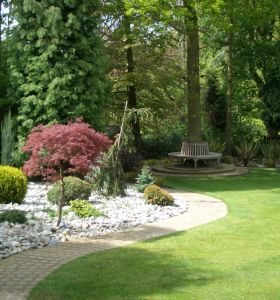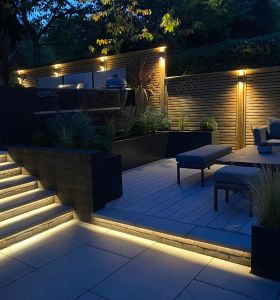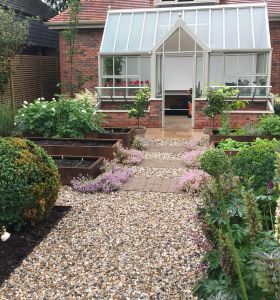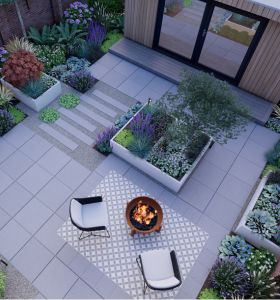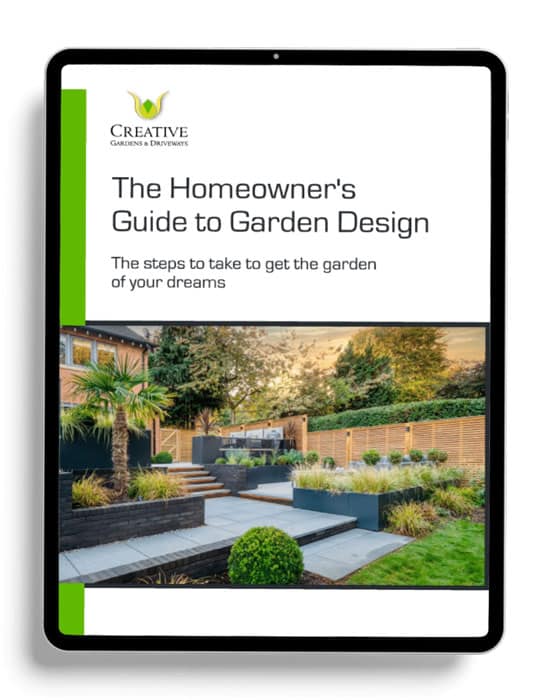Your Guide To Hardscaping Cheshire Gardens
As a leading landscaping company, Creative Gardens & Driveways understands what it takes to create a successful garden design. While each landscape is unique, all successful garden designs combine both hard and soft landscaping elements for a cohesive appearance.
Combining both hard and soft landscaping is a great way to design a balanced and visually appealing outdoor space that is also functional. While soft landscaping refers to the natural, living elements within your garden (such as plants, turf, and flowers), hardscaping adds structure and accessibility.
Features such as pathways, patios, and walls can be used to add structure to your outdoor space and complement your property. However, this only applies if you have chosen the materials and design well to suit your location.
In this guide, we are sharing everything you need to know about hardscaping Cheshire gardens and what works best in this area. Using our experience and skills as paving installers, we are recommending the best methods for hardscaping Cheshire gardens and how you can create an outdoor space that looks amazing throughout the year.
What Is Hardscaping?
Hardscaping refers to all the non-living elements of garden design. These areas typically provide structure, functionality, and accessibility to the garden, as well as additional visual appeal.
Elements such as patios, pathways, terraces, decking, steps, walls and even driveways are considered hardscaping and play an integral role in garden design. When it comes to hardscaping Cheshire gardens, several factors need to be considered to ensure they are the right fit.
The climate and conditions across Cheshire can influence the kind of hardscaping used in your landscape. The soil conditions, typical weather conditions, and style of property will influence which is the best kind of hardscaping for your Cheshire garden. Hardscaping can complement your property and overall garden design when the materials are chosen well.
Factors such as drainage and soil erosion also need to be considered, which are issues for many Cheshire homes. The placement, materials, and structures used in your garden design must support the organic conditions of your garden to prevent future problems.
This is why working with local installers, like Creative Gardens & Driveways, is so beneficial. Our company is based in Cheshire and serves homeowners across the area. We have extensive experience in this region, with most of our team originating from the area, bringing a wealth of local knowledge to every project we undertake. With this, we can recommend the best methods and materials for Cheshire gardens.
The Benefits Of Hardscaping Cheshire Gardens
Through this careful consideration of your property, location and conditions, hardscaping Cheshire gardens can offer a range of benefits, such as:
- Enhances flow and usability of your outdoor space, for example, pathways provide an accessible route through the landscape, or patios create the foundation for seating and dining areas
- Provides year-round visual interest and structure to the garden, as hardscaping does not change with the seasons, unlike soft landscaping elements such as plants and turf
- It can support drainage and prevent issues such as soil erosion, so your garden is more habitable for a range of plants
Increases kerb appeal and property value as a well-designed garden is highly attractive on the property market
When renovating or designing a Cheshire garden, hardscaping elements need to be considered. This ensures that your outdoor space is complete and cohesively designed, as well as fit for purpose. Hardscaping allows you to use your garden all year round and maintain the flow of the space at all times.
In all garden design projects, a combination of soft and hard landscaping is used to create a visually appealing and practical environment.
The Best Hardscaping Materials For Cheshire Gardens
Due to the unique conditions of Cheshire and the various property styles across the region, some hardscaping materials are preferred over others by our clients. To ensure that your outdoor space is attractive and practical, while also complementing your Cheshire home, consider the following materials:
- Sandstone: Locally sourced sandstone is a classic option for garden pathways and patios. The neutral colour and organic texture of these surfaces are the perfect complement to traditional properties and are designed to last a long time.
- Granite: Typically used as edging or patios, this hard-wearing and low-maintenance material is a great option for hardscaping Cheshire gardens. It is a popular design solution for contemporary homes and outdoor spaces, providing a sleek surface that remains in good condition throughout the years.
- Clay Pavers & Reclaimed Bricks: Cottages or traditional properties across Cheshire can benefit from the rustic charm of these pathways, edging, walls and even patio spaces (based on the size of the garden). Using reclaimed bricks and locally sourced materials, this form of hardscaping is a sustainable choice and therefore popular with a lot of homeowners.
- Porcelain: The most popular form of hardscaping for contemporary gardens across Cheshire and the wider region, porcelain can be used in many forms. It is commonly used as pathways and patios, but can be used for steps or wall panels for a modern appeal to the garden. This is also a slip-resistant and colour-stable material that creates safe surfaces which remain the same throughout the years.
- Timber Sleepers: Timber is a great solution for raised beds, edging and rustic features across Cheshire gardens. This traditional outdoor material can be used in many forms and is customisable with various paints and stain colours.
Top Hardscaping Features To Complement Garden Design
There are various ways that hardscaping can be used to complement your garden design and create an effective outdoor space.
As we have mentioned, garden design relies on a combination of soft and hard landscaping features to create a cohesive, lasting environment, and elements such as the following are some of the most popular across the region to ensure this:
Patios
Patios are a wonderful solution to maximise the potential and usable space within your Cheshire garden, and are widely installed across all kinds of properties. To ensure this form of hardscaping Cheshire gardens is effective, you need to choose a suitable size and shape of your paved patio to suit the garden, as well as its intended use.
For example, many Cheshire homeowners use patios as their main outdoor seating or dining areas. This means your new surface needs to be large enough to accommodate this purpose and fit in with the rest of the landscape. Patios should not overshadow soft landscaping elements or look out of place, but rather enhance the flow of design.
A great way to ensure your patio is beneficial and practical is to align its installation with the sun exposure within your garden. This space should capture the most sunlight to create a comfortable and welcoming seating or dining area.
Pathways
When it comes to hardscaping Cheshire gardens, the most common installation is garden pathways. These help to link zones across your landscape and create a cohesive flow throughout the landscape. They are primarily used to improve access throughout the garden.
Pathways also offer visual benefits by leading the eye to key areas of garden design, whether this is leading to a seating area or towards a focal point. They can be adorned with contrasting edging, using paving stones or timber, or planting for a softer appeal.
Steps and Levels
A lot of hardscaping Cheshire gardens is done to counteract and manage sloping landscapes. Many homeowners across the region are dealing with uneven or sloped gardens, which can lead to poor drainage, flooding and soil erosion.
Steps and levels are constructed to make your garden an even, safe surface. They can be used to work with the organic layout of the landscape, such as steps leading between levels, or to counteract it completely. Based on the severity of the slope in your garden, and the conditions caused by this, we can help determine whether levelling or steps are required.
Like pathways, steps provide access throughout the garden and can connect various zones. For example, steps may lead to the main patio area of your garden from the lawn or from the back terrace into the main landscape area, based on the structure of your outdoor space.
Walls And Retaining Features
Similarly, retaining walls are a common way to hardscape Cheshire gardens because they provide structure and elevation. For uneven and sloped gardens, retaining walls can prevent soil erosion and level out main areas of the garden.
Walls and brickwork can also be used to zone the garden or create specific planting areas, based on the garden design you desire.
Focal Points And Features
Hardscaping Cheshire gardens can also be used for focal points such as water features and fire pits. These accessories can also contribute to the functionality of your garden design, as well as create a welcoming environment across the landscape.
Conclusion
Hardscaping is an integral part of garden design and a key feature in Cheshire gardens. There are various forms of hardscaping, from the practical to the decorative, which can be used to complement your new garden design and layout.
For homes in Cheshire, there are specific hardscaping materials and layout ideas that are preferred to align with the property styles and outdoor conditions of the region. As a local landscaping company, Creative Gardens & Driveways understands the best methods for hardscaping Cheshire gardens and provides this expertise in everything we do.
If you want to create a garden that is as beautiful as it is functional, then consider hardscaping.
Contact Us Today
Are you ready to transform your garden? Contact us today to learn more or request a quote.
FAQs
What’s the difference between soft and hard landscaping?
Soft landscaping refers to the natural, living elements of your garden, such as plants, turf and garden maintenance, whereas hardscaping refers to the construction. Paving, patios, and walls are hard landscaping.
Is sandstone a good material for Cheshire gardens?
Yes, sandstone is a popular choice for Cheshire gardens and can be used for pathways and patios. It is hard-wearing, attractive and suits the traditional architecture across the region.
Can I install hardscaping myself, or should I hire a professional?
Working with a garden designer is your best solution for hardscaping installations as it ensures complementary materials, suitable drainage, and long-lasting construction.

